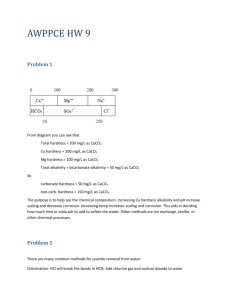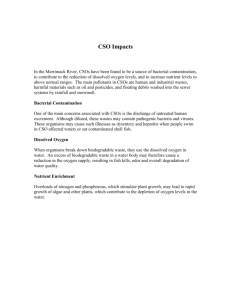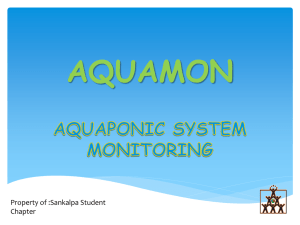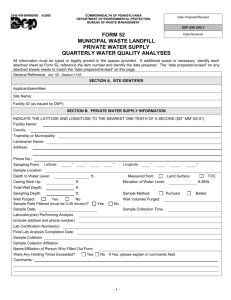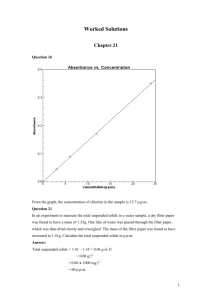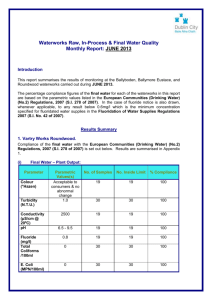Environment pollution control notes
advertisement
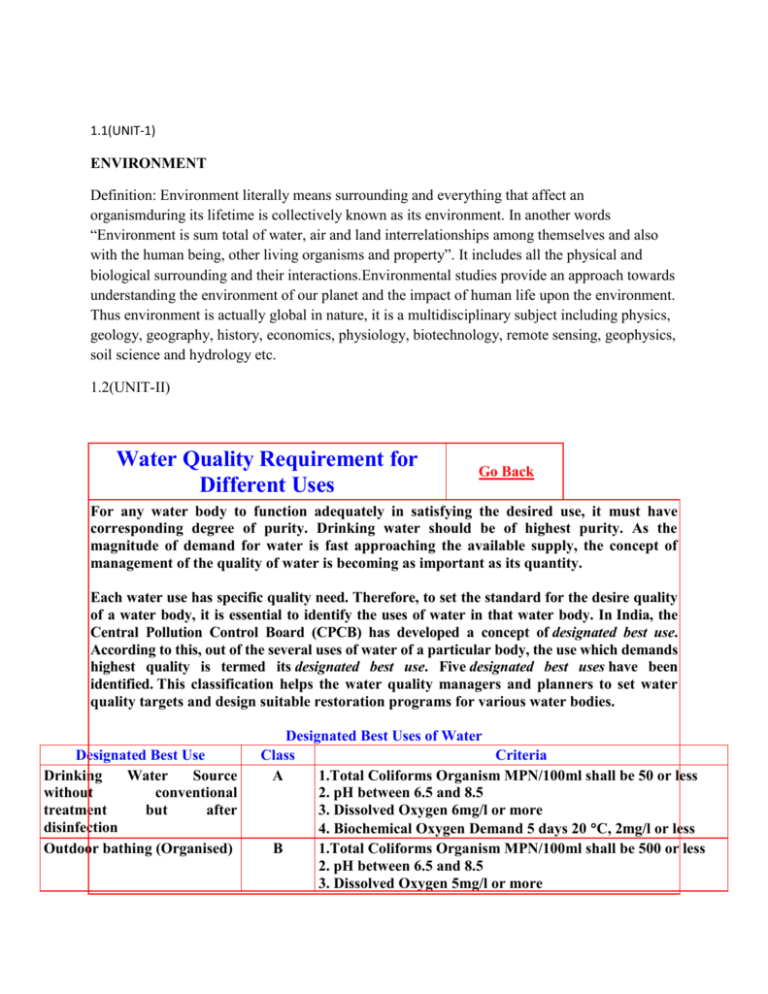
1.1(UNIT-1) ENVIRONMENT Definition: Environment literally means surrounding and everything that affect an organismduring its lifetime is collectively known as its environment. In another words “Environment is sum total of water, air and land interrelationships among themselves and also with the human being, other living organisms and property”. It includes all the physical and biological surrounding and their interactions.Environmental studies provide an approach towards understanding the environment of our planet and the impact of human life upon the environment. Thus environment is actually global in nature, it is a multidisciplinary subject including physics, geology, geography, history, economics, physiology, biotechnology, remote sensing, geophysics, soil science and hydrology etc. 1.2(UNIT-II) Water Quality Requirement for Different Uses Go Back For any water body to function adequately in satisfying the desired use, it must have corresponding degree of purity. Drinking water should be of highest purity. As the magnitude of demand for water is fast approaching the available supply, the concept of management of the quality of water is becoming as important as its quantity. Each water use has specific quality need. Therefore, to set the standard for the desire quality of a water body, it is essential to identify the uses of water in that water body. In India, the Central Pollution Control Board (CPCB) has developed a concept of designated best use. According to this, out of the several uses of water of a particular body, the use which demands highest quality is termed its designated best use. Five designated best uses have been identified. This classification helps the water quality managers and planners to set water quality targets and design suitable restoration programs for various water bodies. Designated Best Use Drinking Water Source without conventional treatment but after disinfection Outdoor bathing (Organised) Designated Best Uses of Water Class Criteria A 1.Total Coliforms Organism MPN/100ml shall be 50 or less 2. pH between 6.5 and 8.5 3. Dissolved Oxygen 6mg/l or more 4. Biochemical Oxygen Demand 5 days 20 C, 2mg/l or less B 1.Total Coliforms Organism MPN/100ml shall be 500 or less 2. pH between 6.5 and 8.5 3. Dissolved Oxygen 5mg/l or more Drinking water source after conventional treatment and disinfection Propagation of Wild life and Fisheries Irrigation, Industrial Cooling, Controlled Waste disposal 4. Biochemical Oxygen Demand 5 days 20 C, 3mg/l or less C 1. Total Coliforms Organism MPN/100ml shall be 5000 or less 2. pH between 6 and 9 3. Dissolved Oxygen 4mg/l or more 4. Biochemical Oxygen Demand 5 days 20 C, 3mg/l or less D 1. pH between 6.5 and 8.5 2. Dissolved Oxygen 4mg/l or more 3. Free Ammonia (as N) 4. Biochemical Oxygen Demand 5 days 20 C, 2mg/l or less E 1. pH between 6.0 and 8.5 2. Electrical Conductivity at 25 C micro mhos/cm, maximum 2250 3. Sodium absorption Ratio Max. 26 4. Boron Max. 2mg/l Below-E Not meeting any of the A, B, C, D & E criteria Source: CPCB A colour coding frequently used to depict the quality of water on maps Blue water This water can be directly used for drinking, industrial use, etc. Green water Water contained in soil and plants is termed as green water White water Atmospheric moisture is white water Brown or grey water Various grades of wastewater are shown by brown or grey colour In India, CPCB has identified water quality requirements in terms of a few chemical characteristics, known as primary water quality criteria. Further, Bureau of Indian Standards has also recommended water quality parameters for different uses in the standard IS 2296:1992. Water Quality Standards in India (Source IS 2296:1992) Characteristics Designated best use A B C D Dissolved Oxygen (DO)mg/l, min 6 5 4 4 Biochemical Oxygen demand 2 3 3 (BOD)mg/l, max Total coliform organisms MPN/100ml, 50 500 5,000 max pH value 6.5-8.5 6.5-8.5 6.0-9.0 6.5-8.5 Colour, Hazen units, max. 10 300 300 Odour Un-objectionable Taste Tasteless Total dissolved solids, mg/l, max. 500 1,500 Total hardness (as CaCO3), mg/l, max. 200 - E 6.0-8.5 2,100 - Calcium hardness (as CaCO3), mg/l, max. Magnesium hardness (as CaCO3), mg/l, max. Copper (as Cu), mg/l, max. Iron (as Fe), mg/l, max. Manganese (as Mn), mg/l, max. Cholorides (as Cu), mg/l, max. Sulphates (as SO4), mg/l, max. Nitrates (as NO3), mg/l, max. Fluorides (as F), mg/l, max. Phenolic compounds (as C2H5OH), mg/l, max. Mercury (as Hg), mg/l, max. Cadmium (as Cd), mg/l, max. Salenium (as Se), mg/l, max. Arsenic (as As), mg/l, max. Cyanide (as Pb), mg/l, max. Lead (as Pb), mg/l, max. Zinc (as Zn), mg/l, max. Chromium (as Cr6+), mg/l, max. Anionic detergents (as MBAS), mg/l, max. Barium (as Ba), mg/l, max. Free Ammonia (as N), mg/l, max Electrical conductivity, micromhos/cm, max Sodium absorption ratio, max Boron, mg/l, max - 200 - - - - 200 - - - - 1.5 0.3 0.5 250 400 20 1.5 0.002 1.5 0.005 1.5 0.5 600 400 50 1.5 0.005 - 600 1,000 - 0.001 0.01 0.01 0.05 0.05 0.1 15 0.05 0.2 0.2 0.05 1 0.01 0.05 0.2 0.05 0.1 15 0.05 1 - - 1 - - - 1.2 - 2,250 - - - - 26 2 - - - Guidelines are available to evaluate quality of water for irrigation. For irrigation, water can be classified in five classes depending upon its chemical properties. Guidelines for Evaluation of Irrigation Water Quality Water class Sodium (Na) % Electrical SAR RSC meq/l conductivity (S/cm) Excellent < 20 < 250 < 10 < 1.25 Good 20 - 40 250 – 750 10 – 18 1.25 – 2.0 Medium 40 - 60 750 – 2,250 18 – 26 2.0 – 2.5 Bad 60 – 80 2,250 – 4,000 > 26 2.5 – 3.0 Very bad > 80 > 4,000 > 26 > 3.0 Drinking Water Specifications (IS 10,500:1991) Characteristics Desirable limit Permissible limit Essential Characteristics Colour, Hazen Units, Max 5 25 Odour Unobjectionable Taste Agreeable Turbidity, NTU, Max 5 10 PH value 6.5 to 8.5 Total Hardness (as CaCo3), mg/l, Max 300 600 Iron (as Fe), mg/l, Max 0.3 1.0 Chlorides (as Cl), mg/l, Max 250 1,000 Residual free chlorine, mg/l, Max 0.2 Desirable Characteristics Dissolved solids, mg/l, Max 500 2,000 Calcium as (Ca), mg/l, Max 75 200 Magnesium (as Mg), mg/l, Max 30 75 Copper (as Cu), mg/l, Max 0.05 1.5 Manganese (as Mn), mg/l, Max 0.1 0.3 Sulphate (as So4), mg/l, Max 200 400 Nitrate (as No3), mg/l, Max 45 100 Flouride (as F0, mg/l, Max 1.0 1.5 Phenolic compounds (as C6H5OH), mg/l, 0.001 0.002 Max Mercury (as Hg), mg/l, Max 0.001 Cadmium (as Cd), mg/l, Max 0.01 Selenium (as Se), mg/l, Max 0.01 Arsenic (as As), mg/l, Max 0.05 Cyanide (as CN), mg/l, Max 0.05 Lead (as Pb), mg/l, Max 0.05 Anionic detergents (as MBAS), mg/l, Max 0.02 1.0 6+ Chromium (as Cr ), mg/l, Max 0.05 PAH, mg/l, Max Mineral oil, mg/l, Max 0.01 0.03 Pesticides, mg/l, MAX Absent 0.001 Alkalinity, mg/l, Max 200 600 Aluminum (as Al), mg/l, Max 0.03 0.2 Boron, mg/l, Max 1 5
